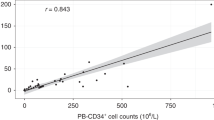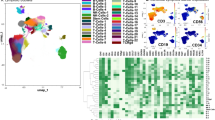Abstract
Better predictive factors for autologous blood stem cell mobilization (BSCM) are needed. The purpose of this study was to determine if an independent association exists between lymphocyte or NK cell counts and BSCM. Data were analyzed on 141 consecutive patients aged 19–69 years (median 45) who received combined chemotherapy plus G-CSF for BSCM, and who had measurements of immune cells prior to BSCM. Of the 141 patients, 41% had breast cancer, 14% Hodgkin's disease, 34% non-Hodgkin's lymphoma, and 11% other diagnoses. BSCM involved dose-intensive cyclophosphamide, etoposide, cisplatin (DICEP) plus G-CSF 300 μg (<70 kg) or 480 μg (>70 kg) for 45% of patients, while the remaining 55% received other chemotherapy plus similar doses of G-CSF. Only a single apheresis was performed for 94% of patients. The following factors were analyzed for predictors of BSCM: age, gender, prior chemotherapy, prior radiotherapy, diagnosis, disease status, marrow involvement, mobilization regimen, Hb, WBC, platelet count, B cell, T cell, and NK cell counts. The peripheral blood CD34+ counts on the first day of apheresis (PBCD34) were 6–1783 × 106/l (median 150). The PBCD34 count correlated strongly with the number of CD34+ cells collected/l blood apheresed and with the number of CD34+ cells collected/kg. By multivariate analysis using continuous variables, relapsed status (P = 0.0003), not using DICEP mobilization (P = 0.0001), female gender (P = 0.0057), low platelet count (P = 0.051), and low CD3−16+56+ count (P = 0.0158) were associated with low PBCD34 counts. Using categorical variables, the only factors that independently predicted a PBCD34 count <150 × 106/l were: >1 prior chemotherapy regimen (odds ratio = 5.12, P = 0.0003), not using DICEP mobilization (odds ratio = 4.94, P = 0.0001), and CD3−16+56+ count <125 × 106/l (odds ratio = 2.58, P = 0.0157). In conclusion, the CD3−16+56+ count may be a useful additional predictor of BSCM and warrants further study. Bone Marrow Transplantation (2001) 27, 1237–1243.
This is a preview of subscription content, access via your institution
Access options
Subscribe to this journal
Receive 12 print issues and online access
$259.00 per year
only $21.58 per issue
Buy this article
- Purchase on Springer Link
- Instant access to full article PDF
Prices may be subject to local taxes which are calculated during checkout


Similar content being viewed by others
References
Siena S, Schiavo R, Pedrazzoli P, Carlo-Stella C . Therapeutic relevance of CD34 cell dose in blood cell transplantation for cancer therapy J Clin Oncol 2000 18: 1360–1377
To LB, Haylock DN, Simmons PJ, Juttner CA . The biology and clinical uses of blood stem cells Blood 1997 89: 2233–2258
Stewart DA, Guo D, Morris D et al. Superior autologous blood stem cell mobilization from dose-intensive cyclophosphamide, etoposide, cisplatin plus G-CSF than from less intensive chemotherapy regimens Bone Marrow Transplant 1999 23: 111–117
Gajewski JL, Donato M, Anderlini P et al. Intensive chemotherapy with G-CSF mobilization yields improved peripheral blood progenitor cell (PBPC) collection, quicker recovery after high dose chemotherapy and reduces progression risk compared to G-CSF alone for mobilization Blood 1999 94: (Suppl. 1) 665a (Abstr. 2953)
Gazitt Y, Freytes CO, Callander N et al. Successful PBSC mobilization with high dose G-CSF for patients failing a first round of mobilization J Hematother 1999 8: 173–183
Facon T, Harousseau JL, Maloisel F et al. Stem cell factor in combination with filgrastim after chemotherapy improves peripheral blood progenitor cell yield and reduces apheresis requirements in multiple myeloma patients: a randomized, controlled trial Blood 1999 94: 1218–1225
Stiff PJ . Management strategies for the hard-to-mobilize patient Bone Marrow Transplant 1999 23: (Suppl. 2) S29–S33
Weaver CH, Schwartzberg LS, Birch R et al. Collection of peripheral blood progenitor cells after the administration of cyclophosphamide, etoposide, and granulocyte-colony-stimulating factor: an analysis of 497 patients Transfusion 1997 37: 896–903
Mackall CL, Fleisher TA, Brown MR et al. Age, thymopoiesis, and CD4+ T-lymphocyte regeneration after intensive chemotherapy New Engl J Med 1995 332: 143–149
Sewell HF, Halbert CF, Robins RA et al. Chemotherapy-induced differential changes in lymphocyte subsets and natural killer cell function in patients with advanced breast cancer Int J Cancer 1993 55: 735–738
Brittenden J, Heys SD, Ross J et al. Natural cytotoxicity in breast cancer patients receiving neoadjuvant chemotherapy: effects of L-arginine supplementation Eur J Surg Oncol 1994 20: 467–472
Bonilla A, Alvvarez-Mon M, Merino F et al. Natural killer activity in patients with breast cancer Eur J Gynaecol Oncol 1990 11: 103–109
Miller JS, Alley KA, McGlave P . Differentiation of natural killer (NK) cells from human primitive marrow progenitors in a stroma-based long-term culture system: identification of a CD34+7+ NK progenitor Blood 1994 83: 2594–2601
Kulkarni S, Powles R, Cunningham D et al. Factors predicting failure to mobilize adequate CD34 positive cells (2 × 106/kg) after priming with growth factors Blood 2000 96: 519a (Abstr. 2233)
Perry AR, Watts MJ, Peniket AJ et al. Progenitor cell yields are frequently poor in patients with histologically indolent lymphomas especially when mobilized within 6 months of previous chemotherapy Bone Marrow Transplant 1998 21: 1201–1205
Olavarria E, Kanfer EJ . Selection and use of chemotherapy with hematopoietic growth factors for mobilization of peripheral blood progenitor cells Curr Opin Hematol 2000 7: 191–196
Ketterer N, Salles G, Tremisi P et al. Analysis of factors influencing 300 peripheral blood progenitor cell (PBPC) collections in 273 patients treated for lymphoproliferative diseases Blood 1997 90: (Suppl. 1) 213a (Abstr. 939)
Bensinger W, Appelbaum F, Rowley S et al. Factors that influence collection and engraftment of autologous peripheral blood stem cells J Clin Oncol 1995 13: 2547–2555
Brittenden J, Heys SD, Ross J, Eremin O . Natural killer cells and cancer Cancer 1996 77: 1226–1243
Brenner BG, Gryllis C, Gornitsky M et al. Differential effects of chemotherapy-induced and HIV-1-induced immunocompromise on NK and LAK cell activities using breast cancer and HIV-1 seropositive patient populations Anticancer Res 1991 11: 969–974
Talmadge J, Reed E, Ino K et al. Rapid immunologic reconstitution following transplantation with mobilized peripheral blood stem cells as compared to bone marrow Bone Marrow Transplant 1997 19: 161–172
Roberts M, To L, Gillis D et al. Immune reconstitution following peripheral blood stem cell transplantation autologous marrow transplantation and allogeneic bone marrow transplantation Bone Marrow Transplant 1993 12: 469–475
Bomberger C, Singh-Jairam M, Rodey G et al. Lymphoid reconstitution after autologous PBSC transplantation with FACS-sorted CD34+ hematopoietic progenitors Blood 1998 91: 2588–2600
Lotzova E, Savary C, Champlin R . Genesis of human oncolytic natural killer cells from primitive CD34+33− bone marrow progenitors J Immunol 1993 150: 5263–5269
Klingemann H-G . Relevance and potential of natural killer cells in stem cell transplantation Biol Blood Marrow Transplant 2000 6: 90–99
Miller JS, Verfaillie C, McGlave P . The generation of human natural killer cells from CD34+/DR− primitive progenitors in long-term bone marrow culture Blood 1992 80: 2182–2187
Verfaillie CM . Direct contact between human primitive hematopoietic progenitors and bone marrow stroma is not required for long-term in vitro hematopoiesis Blood 1992 79: 2821–2826
Bautz F, Rafii S, Kanz L, Mohle R . Expression and secretion of vascular endothelial growth factor-A by cytokine-stimulated hematopoietic progenitor cells. Possible role in the hematopoietic microenvironment Exp Hematol 2000 28: 700–706
Papayannopoulou T . Hematopoietic stem/progenitor cell mobilization. A continuing quest for etiologic mechanisms Ann NY Acad Sci 1999 872: 187–197
Burns LJ, Weisdorf DJ, DeFor TE et al. Enhancement of the anti-tumor activity of a peripheral blood progenitor cell graft by mobilization with interleukin 2 plus granulocyte colony-stimulating factor in patients with advanced breast cancer Exp Hematol 2000 28: 96–103
Fruehauf S, Wilmes A, Weber-Nordt R et al. G-CSF dose-dependent progenitor cell mobilization in healthy donors: results of a randomized study using baseline CD34+ cell counts Blood 2000 96: 179a (Abstr. 771)
Schooley RT, Mladenovic J, Sevin A et al. Reduced mobilization of CD34+ stem cells in advanced human immunodeficiency virus type 1 disease J Infect Dis 2000 181: 148–157
Osma MM, Ortuno F, de Arriba F et al. Bone marrow steady-state CD34+/CD71− cell content is a predictive value of rG-CSF-mobilized CD34+ cells Bone Marrow Transplant 1998 21: 983–985
Acknowledgements
We thank Jan McLaughlin for data collection and management. Research support was by Alberta Cancer Foundation Grant No. 2350003.
Author information
Authors and Affiliations
Rights and permissions
About this article
Cite this article
Stewart, D., Guo, D., Luider, J. et al. The CD3−16+56+ NK cell count independently predicts autologous blood stem cell mobilization. Bone Marrow Transplant 27, 1237–1243 (2001). https://doi.org/10.1038/sj.bmt.1703070
Received:
Accepted:
Published:
Issue Date:
DOI: https://doi.org/10.1038/sj.bmt.1703070
Keywords
This article is cited by
-
Does mRNA level of microsomal carnitine palmitoyltransferase predict yield of peripheral blood stem cell apheresis?
Annals of Hematology (2006)
-
The whys and hows of hematopoietic progenitor and stem cell mobilization
Bone Marrow Transplantation (2003)



